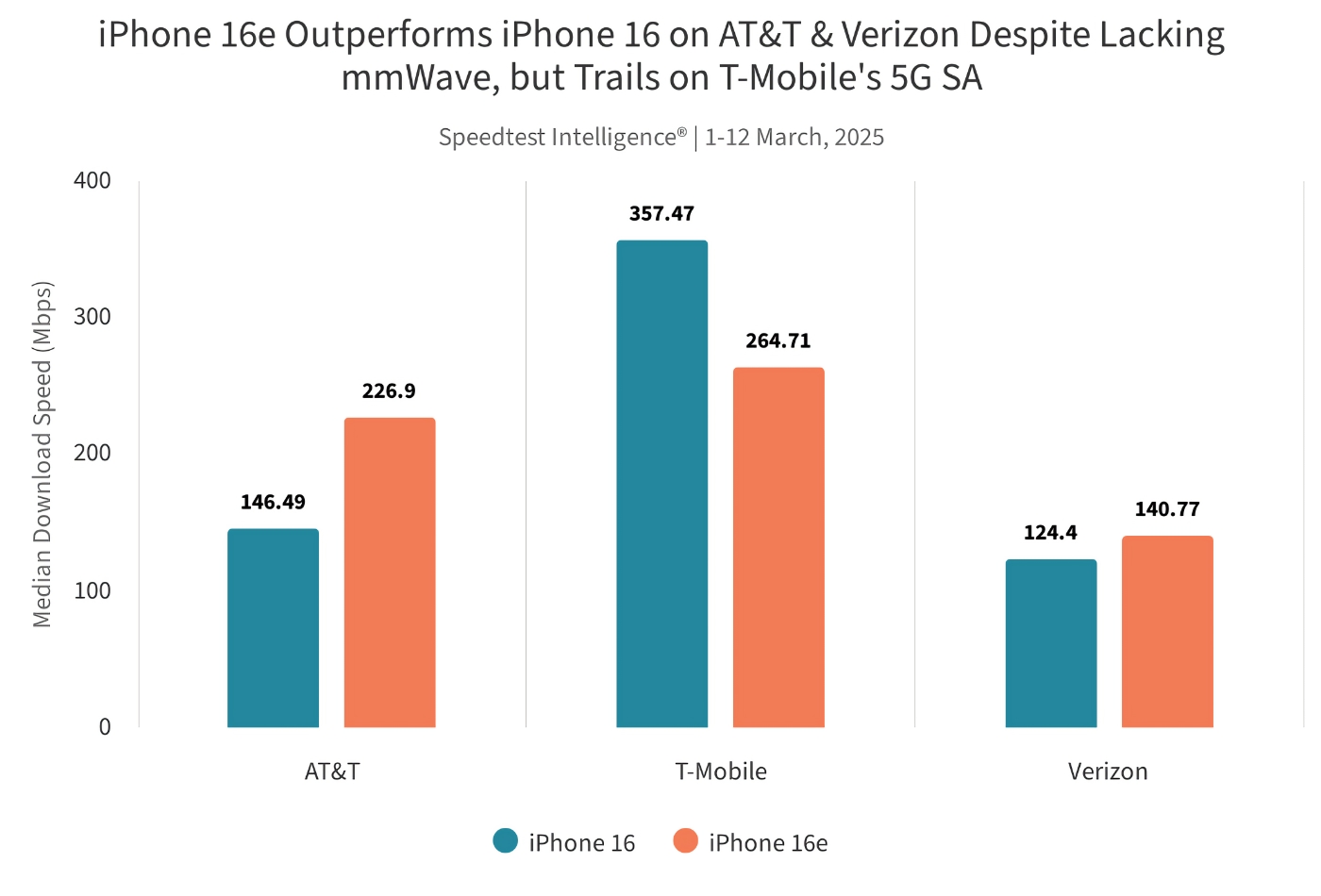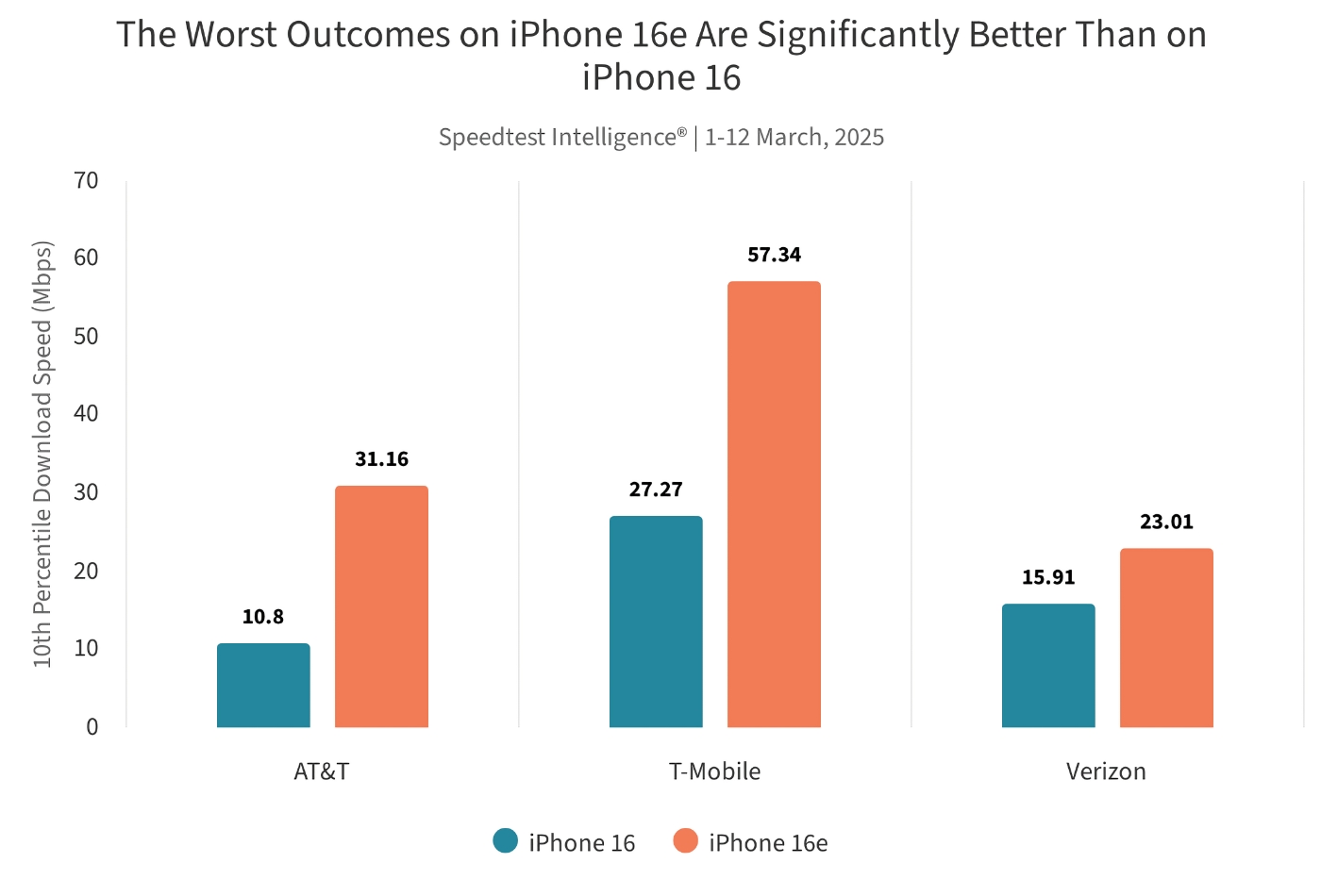Real-World Tests Show the iPhone 16e C1 Modem Chip is a Serious Contender

Toggle Dark Mode
The iPhone 16e may be underwhelming in some ways, but it’s turning out to be an excellent opportunity for Apple to field test something it’s been working on for at least seven years. Along with a slightly scaled-down version of Apple’s A18 chip, Apple’s new “budget” iPhone includes a C1 chip: the first generation of a 5G modem developed entirely in-house by Apple’s engineers.
The new chip represents a sea change from years of relying on Qualcomm to provide the 5G cellular connectivity in Apple’s iPhones. While Apple prefers to develop as many pieces of its products as possible in-house, its modem chip efforts kicked into high gear in 2019 after a nasty fight with Qualcomm and Intel’s failure to launch a viable competitor.
Apple picked up Intel’s 5G modem business for a mere $1 billion (about the same amount of money it reportedly loses on Apple TV+ every month) and began the long road of designing its own 5G modem. In the meantime, it paid off Qualcomm to guarantee it a supply of modem chips for future iPhones while it perfected its own.
That work has culminated in the C1, and while it’s not ready to rival Qualcomm’s Snapdragon X-series chips in every way, Apple’s first attempt shows it holding its own.
Apple didn’t say anything about the C1 chip’s cellular performance when it first launched the iPhone 16e, choosing to focus on its increased power efficiency. This led some to believe Apple avoided talking about cellular performance because it had nothing to brag about. While that’s partially true — Qualcomm’s chips are still more powerful, and support features the C1 lacks, like four-link carrier aggregation and mmWave — real-world tests are showing the C1 to be a surprisingly solid modem for Apple’s new entry-level iPhone.
A new report by Ookla has looked at speed tests from early iPhone 16e adopters in the United States that reveal it outperforming the more expensive iPhone 16 in many cases.
Sadly, it’s not universally faster in every case. The report said that while folks on A&T and Verizon “experienced better median download speeds on the iPhone 16e than iPhone 16 […] the opposite was true for T-Mobile users.”
In raw numbers, the iPhone 16e experienced median download speeds of 140.77 Mbps on Verizon, 226.90 Mbps on AT&T, and 264.71 Mbps on T-Mobile. For AT&T customers, the iPhone 16e represented a significant jump from 146.49 Mbps for the iPhone 16, while those on Verizon only came out slightly ahead compared to the iPhone 16’s 124.4 Mbps score.
Still, iPhone 16 users on T-Mobile left everything else in the dust, clocking in with staggering median download speeds of 357.47 Mbps.
The lower results on T-Mobile are likely due to poorer support of 5G SA (Standalone) technology on Apple’s C1 modem compared to the Qualcomm chips used in the rest of the iPhone 16 lineup.
Some of these differences can also be chalked up to different 5G bands and technologies each carrier uses. The iPhone 16e also lacks mmWave support, which will give the iPhone 16 an edge in heavily congested areas like airports and stadiums where extremely high-frequency coverage is needed to support thousands of simultaneous 5G connections.
Ookla also found that the iPhone 16e performed better on all three carriers under poorer network conditions — areas where download speeds are below 100 Mbps due to congestion, lower-band 5G frequencies, or weak coverage. T-Mobile and AT&T iPhone 16e customers saw median download speeds in the lower 10th percentile that were more than twice as fast as iPhone 16 users, while Verizon iPhone 16e users saw a more modest 44% increase.
The opposite was true at the other end of the scale. Under ideal network conditions — when top speeds are available — the Qualcomm X71 modem in the iPhone 16 dominated Apple’s C1 chip, delivering median download speeds in the upper 90th percentile that were 16–42% faster than the iPhone 16e, depending on the carrier. The fastest was T-Mobile, with speeds of up to 889.83 Mbps on the iPhone 16 versus a still very respectable 627.01 Mbps on the iPhone 16e. The slowest was Verizon, where the iPhone 16e still came in at 496.03 Mbps.
Unless you’re in that bottom tenth percentile, these 5G speeds are fast enough that most folks are unlikely to notice the difference — except when you’re running speed tests. However, if you live in a fringe coverage area, the iPhone 16e may offer better 5G performance than a standard iPhone 16 model.
Fortunately, Apple doesn’t appear to be moving away from Qualcomm chips quite yet. The iPhone 16 used a Snapdragon X71 that’s believed to be a custom derivative of the more mainstream X75. While some reports suggest the so-called “iPhone 17 Air” will also adopt the C1 chip, the rest of the iPhone 17 lineup is expected to stick with Qualcomm. It will likely get a variation on the Snapdragon X80, which debuted in early 2024 and can already be found in the latest flagships from Samsung.
Due to different release cycles, Apple tends to lag six months or more behind rival Android smartphones. Qualcomm announces its new chips at Mobile World Congress (MWC) each year in March — it just announced the X85 earlier this month, but that’s usually too late for them to be incorporated into Apple’s iPhones, which are typically finalized and preparing to enter validation testing at this point.
Apple is reportedly already working on a next-generation C2 chip and possibly even a C3 for inclusion in future devices. There’s a good chance next year’s iPhone 18 lineup may be the first to gain that new chip, which will likely improve the specs enough to make it a suitable replacement for Qualcomm’s chips. Although it will likely be a while before Apple catches up to Qualcomm to match its chips spec-for-spec, modern Snapdragon X-series chips have become seriously overpowered for what most smartphone users need, so Apple doesn’t have to reach the bar; it merely has to produce a chip that’s good enough to deliver solid 5G connectivity with low latency and reasonable speeds. After all, how many iPhone users really need 500 Mbps+ download speeds?










